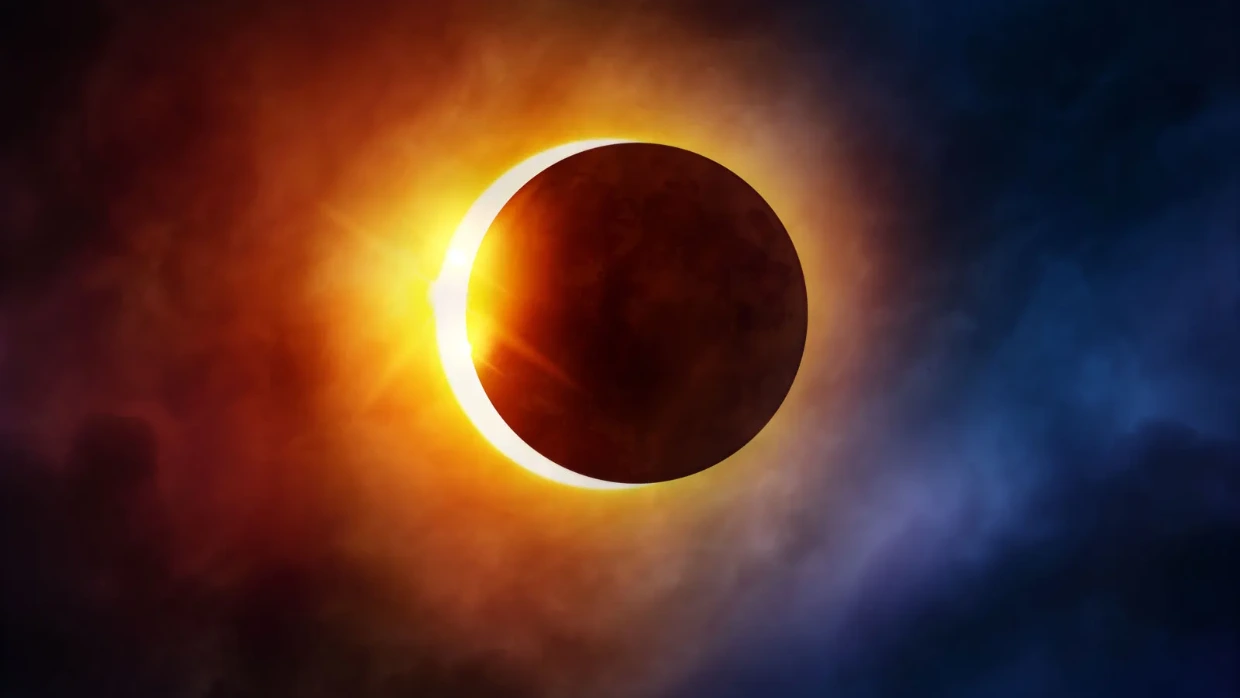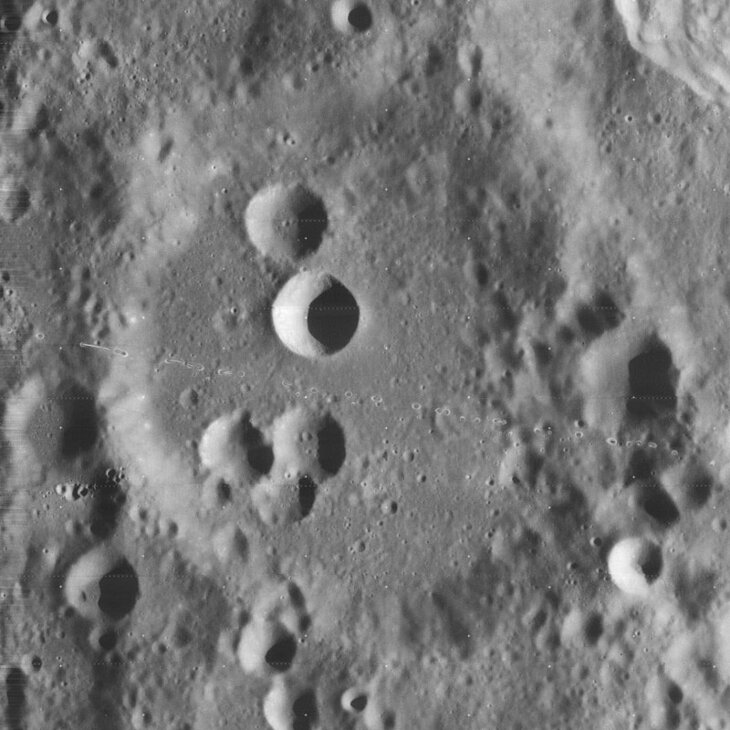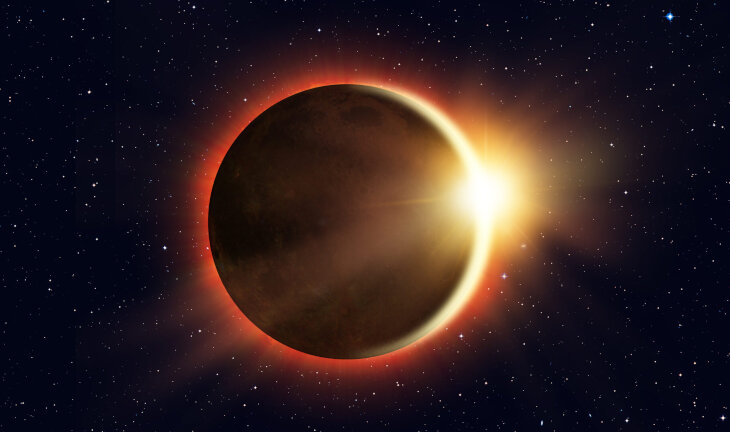 Identifying as a Jew
Identifying as a Jew


11 min read
What is the deeper meaning behind this natural phenomenon?
Eclipse fever is growing as many people anticipate the “Great American Eclipse” on April 8th 2024. A total solar eclipse will turn day into night across North America in a path from the southwest to the northeast.
Many Jews are even more excited, thanks to being connected historically and spiritually to the upcoming event. Judaism has always had a fascination with astronomy, because of the necessity of that science for computing the Jewish calendar and because it serves as a gateway to getting a glimpse of the wondrous nature of God, as King David wrote in Psalms, the “heavens speak of the honor of God.”1
You may be surprised to find out that there are three craters on the moon named after medieval Rabbis. Zagut, is named after Rabbi Avraham Zaccutto,2 whose astronomical charts were used by Christopher Columbus.
Rabbi Levi,3 is named after Rabbi Levi ben Gershom (Gersonides) a Biblical commentator, philosopher and astronomer. Gersonides is believed to have invented an instrument to measure the azimuth of stars, called Jacob’s Staff,4 and describes it in one of his books.5 He also personally observed a solar eclipse in Portugal on March 3rd 1337.6
 Rabbi Levi crater
Rabbi Levi crater
The crater, Abenezra, is named after the commentator, poet and grammarian, Abraham ibn Ezra.7
Maimonides, the great 12th century Jewish scholar and physician of Cairo, wrote his first book at the age of about 18, on the subject of astronomy and mathematics,8 and the Talmudic Sage, Samuel, was known by the monicker, Samuel of the Moon,9 because of his interest in, and knowledge of astronomy. The ancient astronomical instrument, the astrolabe,10 gets a mention in the Code of Jewish Law,11 in a discussion about the permissibility of its use on the Sabbath, and there is a possible reference to a very early telescope prototype in the Talmud (circa 500 CE). “Rabban Gamliel had a special tube through which he would look and see a distance of two thousand cubits on land, and also determine a corresponding distance of two thousand cubits at sea.”12
The fascination of Rabbis with astronomy can be attributed, at least in part, to the Jewish calendar. The Bible references the festivals by their dates in the lunar month, but also relates the festivals to the seasons of the solar year. “And God spoke to Moses and Aaron in the land of Egypt, saying, This month shall be to you the beginning of months; it shall be the first month of the year to you.”13 This means that although Judaism uses a lunar calendar, where the beginning of the month is the new moon and the middle of the month a full moon, it adjusts (“intercalates”) the calendar to synchronize both lunar and solar cycles. All this requires knowledge of astronomy and mathematics, both of which take on a religious significance in Jewish thought.14
In addition, the Rabbis of the Talmud encouraged the study of astronomy and the performance of astronomical calculations as being a mitzvah, a religious precept. “Anyone who knows how to calculate astronomical times and constellations and does not do so, the verse says about him: “They do not take notice of the work of God, and they do not see His handiwork” (Isaiah 5:12)…. From where is it derived that there is a mitzvah incumbent upon a person to calculate astronomical seasons and constellations? As it was stated: “And you shall guard and perform, for it is your wisdom and understanding in the eyes of the nations” (Deuteronomy 4:6).15
Some explain that the religious duty of performing astronomical calculations is based on these calculations indicate that the world is rational and understandable to the human mind which is a strong argument for a rational and purposeful Creator, who is interested in a relationship with the human being.16 The very fact that the world can be described in logical terms, using mathematical algorithms indicates that the world is not haphazard or random. As Albert Einstein put it in a letter to a friend, “You find it surprising that I think of the comprehensibility of the world… as a miracle or eternal mystery. But surely, a priori, one should expect the world to be chaotic, not to be grasped by thought in any way.”17
The most incomprehensible thing about the universe is its comprehensibility.
The pithy way to paraphrase this is, “The most incomprehensible thing about the universe is its comprehensibility.” Mathematics, deductive logic and the scientific method are incredibly effective in understanding the universe. As the mathematician Morris Kline writes:
A study of mathematics and its contribution to the sciences exposes a deep question. The concepts, the broad ideas, the logical standards and method of reasoning… were fashioned by human beings. Yet with the product of his fallible mind, man has surveyed spaces too vast for his imagination to encompass; he has predicted and shown how to control radio waves which none of our senses can perceive; and he has discovered particles too small to be seen by the most powerful microscope… Some explanation of this marvelous power is called for.18”
So the prediction of the eclipse with complete accuracy and the plotting of its path of visibility are, in the words of the Talmud, a religious precept, a mitzvah, and in the words of Einstein, “a miracle, or eternal mystery.
The total solar eclipse on May 29, 1919 actually proved Einstein’s theory that the mass of objects curves space and hence affects light’s path through space.19 In a famous paper, three scientists, Arthur Eddington, Frank Watson Dyson, and Charles Davidson, concluded, “Thus the results of the expeditions to Sobral and Príncipe can leave little doubt that a deflection of light takes place in the neighborhood of the sun and that it is of the amount demanded by Einstein’s generalized theory of relativity, as attributable to the sun’s gravitational field.”20
A possible reference to the phenomenon of the eclipse is found in a famous Biblical passage in Genesis, “God said, ‘Let there be lights in the expanse of the sky to separate day from night; they shall serve as signs for the set times—the days and the years; and they serve as lights in the expanse of the sky to shine upon the earth.’ And it was so. God made the two great lights, the greater light to dominate the day and the lesser light to dominate the night, and the stars.”21 Rashi,22 the Biblical commentor, notes that the verse refers to the sun and moon as “the great luminaries” implying that they are equal in size, yet in the same verse refers to “the greater light” and “the lesser light.”23 We know that although the moon is about 400 times smaller than the sun, it appears to us to be same size because it is also about 400 times closer to the earth, hence its apparent size is the same as the sun, thus enabling a total eclipse of the sun by the moon.24 Given these facts, some suggest that the statement, “the great luminaries” refers to the apparent size of the sun and moon, and the statements “the greater” and “the lesser” refer to the actual sizes of the sun and moon.25

Eclipses have always been somewhat frightening and awe-inspiring. As William Shakespeare wrote, “These late eclipses of the sun and moon portend no good to us.”26 In a similar vein the Talmud states, “The Sages taught: When the sun is eclipsed it is a bad omen for the entire world. To what is this matter comparable? It is comparable to a king of flesh and blood who prepared a feast for his servants and placed a lantern before them to illuminate the hall. He became angry at them and said to his servant: Take the lantern from before them and seat them in darkness.”27
Many commentaries on the Talmud find this statement perplexing. Since an eclipse is a natural and predictable phenomenon, how could it be a “bad omen” or an indication of sin, as the Talmud28 suggests?
One scholar concluded that the Talmud is not referring to an eclipse but rather the phrase in the Talmud “eclipse of the sun” literally, “blemish or affliction of the sun” refers to sunspots.29 Most commentaries reject this approach and understand the Talmud as referring to a solar eclipse. If so, how do they explain the idea that the natural, predictable eclipse is somehow a “bad omen”?
The Maharal of Prague,30 the great 16th century thinker Rabbi Yehuda Loew, maintains that the Sages understood that the phenomenon is natural, but the Talmud is explaining the “reason of the reason,” that is, why God created the orbits in such a way as to produce occasional eclipses. He explains that light symbolizes reality and existence, and darkness symbolizes chaos and illusion. Because God gave humanity freedom of will, He knew that sin would be inevitable and that people would often choose chaos over order, and illusion over reality. He created a system that would remind us regularly that our choices can create darkness, even at times when there should be light, and that our free will choices can create a barrier between us and the Divine light, but can also allow Divine light to be seen here.31
A note of caution; it is extremely dangerous to look directly at the sun at any time, however, usually we instinctively look away because of its brightness. During an eclipse when the moon covers most or all of the sun, the lower brightness makes it easier to look at and it is also more interesting than usual. Care should therefore be taken to use appropriate eye protection, and ideally to only view the eclipse using projection.32
However, make sure you don’t miss this incredible event, something that is linked to the creation of the universe, to the Jewish calendar, to Jewish monotheism, and to Jewish history. Most importantly the eclipse is a demonstration of the power of light and darkness and a reminder of the ultimate power of human free will to obscure light but also to reveal light.

What should be truly interesting to us, as believing jews is that the moon , being 400 times closer to us can cover the sun which 400 times greater. There are no accidents in haShem's world
Absolutely Correct!
And this phenomenon does not occur anywhere else in the solar system!
So why did Hashem make this extraordinary coincidence happen?
It is well established scientifically that if the earth were just a few percent closer to the sun or further from the sun, life on earth would not be possible.
But this is something that a non-scientist does not readily appreciate.
However, this extraordinary "coincidence" that the moon blocks out the sun during an eclipse and appears to be the exact same size as the sun, is something that is evident to anyone who sees it.
This would thus seem to be Hashem's signature demonstrating to all that He is the Creator.
Boruch Oseh Maaseh Bereishes!
BR (EISH) IS = BRIS AISH, Covenant of fire!
Looking at the very first word of the Torah, I discovered this play on words.
------------------------------------------------------------------------------------------------
Staring into space, in the sky, or into words, can sometimes reveal hidden ideas.
In our fast paced life, today, it is a challenge to concentrate, slowly and find meaning.
I happened to life in Rochester, NY, where we hope to see a total eclipse, April 8.
Normal activity, here will cease, here, and then life will go back to normal chaos!
Thanks, so much for this incredible information, Rabbi Becher... H
CLOUDY LESSON from the Eclipse, in Rochester, NY
I went to a Shul to watch the eclipse, but the sun was clouded over.
The Moon blotted out the sun, but the clouds blotted out the eclipse.
But it still got dark, and perhaps there is a great lesson in cloudy thinking.
So much of life's activities are hidden from us, but if we patiently keep searching, we may be able to reveal some of it's mysteries for ourselves and for others.
And there may be great joy, simcha, and accomplishment when our searching works!
Thanks, again, Rabbi Becher for making a Jewish connection...
is it not safe to look at the sun directly and unprotected during totality?
I thought that was the whole draw of being in the line of totality, observing the corona and solar flares and all...
Only with special glasses.
So I bought the book.
Page 38:
The only time that it is completely safe to look at a solar eclipse is during its total phase, when 100% of the photosphere is covered by the Moon. But this magnificent phase is surrounded by the two most dangerous parts - the minute or so immediately before and after totality. During these times, it is possible to see the dark Moon even though the Sun is still shining brightly, and its thin line of sunlight is highly dangerous to your retinas. Ad Kan.
Safest idea would be to set a timer, based on calculated totality at your location, to know when it is no longer safe.
Can't experience anything of the grandeur of totality when wearing those black-out glasses.
and you won’t experience the grandeur of seeing the rest of the world if you burn out your retinas. don’t be an idiot.
Thanks for caring.
But it is truly safe to look at the sun during totality. Millions of people have. No timer is needed either. Just wait until the sun is completely covered, and look away when it starts becoming visible.